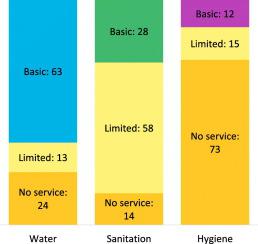Science of the Total Environment ( IF 8.2 ) Pub Date : 2020-12-04 , DOI: 10.1016/j.scitotenv.2020.144226 Ryan Cronk , Amy Guo , Lisa Fleming , Jamie Bartram

|
Improving access to water, sanitation, and hygiene (WaSH) and menstrual hygiene management (MHM) in schools is important to achieve Sustainable Development Goals (SDGs) 3 and 6. Inadequate WaSH and MHM in schools adversely affect student health and educational performance, as well as teacher satisfaction. However, there is little evidence describing factors associated with WaSH services and MHM in schools. We conducted 2,690 surveys and collected 1,946 water samples at randomly selected schools in rural areas of 14 low- and middle-income countries (LMICs). We developed multilevel mixed-effects logistic regression models to identify factors associated with basic water services, water quality, basic sanitation facilities, basic handwashing facilities, and availability of MHM materials. We found that 51% of schools had at least a basic, on-premises water service. Twenty-eight percent of schools had at least basic sanitation services, 12% had at least a basic handwashing facility, and 26% had MHM materials available. Four percent of schools had all basic WaSH services. Half (52%) of schools had drinking water compliant with the WHO guideline value for E. coli. In regression models, we found that schools that did not share their water point with a community, had a parent-teacher association that supported WaSH, or had support from an external WaSH program were more likely to have access to basic, continuous, on-premises water service versus worse access. Schools with an on-premises water point, water available on the day of survey, a health club, or handwashing stations near toilets were more likely to have a basic sanitation service versus a lower service. Schools with limited or basic sanitation, health clubs, an MHM curriculum, a designated MHM focal person, or school funds for WaSH were more likely to have MHM materials. We conclude that improved institutional management and external support, accountability mechanisms, and enhanced training and hygiene curriculum will support sustained WaSH service delivery in schools in LMICs.
中文翻译:

14个中低收入国家/地区乡村学校中与水质,环境卫生和个人卫生有关的因素
改善学校的水,卫生与卫生(WaSH)和月经卫生管理(MHM)的获取对于实现可持续发展目标(SDG)3和6至关重要。学校的WaSH和MHM不足会对学生的健康和教育表现产生不利影响,因为以及老师的满意度。但是,很少有证据描述与学校中的WaSH服务和MHM相关的因素。我们在14个低收入和中等收入国家(LMIC)农村地区的随机选择的学校中进行了2690个调查,并收集了1946个水样本。我们开发了多层次的混合效应逻辑回归模型,以识别与基本水服务,水质,基本卫生设施,基本洗手设施和MHM材料的可用性相关的因素。我们发现51%的学校至少有基础,本地供水服务。28%的学校至少有基本的卫生服务,12%的至少有基本的洗手设施,26%的有MHM可用材料。百分之四的学校提供所有基本的WaSH服务。一半(52%)的学校的饮用水符合世界卫生组织指导值大肠杆菌。在回归模型中,我们发现不与社区共享水位,拥有支持WaSH的家长教师协会或获得外部WaSH计划支持的学校更有可能获得基本的,连续的,在线的-处所供水服务与较差的获取。拥有自来水点,在调查当天可用水,健身俱乐部或洗手间附近的洗手站的学校更有可能提供基本的卫生服务,而不是较低的服务。卫生条件有限或基本卫生的学校,健身俱乐部,MHM课程,指定的MHM联络人或用于WaSH的学校资金更可能拥有MHM材料。我们得出的结论是,改善了机构管理和外部支持,问责机制,











































 京公网安备 11010802027423号
京公网安备 11010802027423号